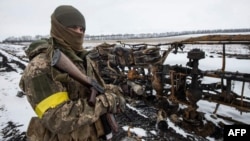ເມືອງບັກມູຕຢູ່ໃນພາກຕາເວັນອອກຂອງຢູເຄຣນຕັ້ງຢູ່ຫ່າງຈາກທີ່ໝັ້ນຂອງກອງ ກຳລັງຣັດເຊຍ 15 ກິໂລແມັດ ຊຶ່ງໜ່ວຍປືນໃຫຍ່ພວມລໍຖ້າສັນຍານຢູ່ນັ້ນ.
ມີສຽງຮ້ອງວ່າ “ພ້ອມແລ້ວ!” ທະຫານສີ່ຄົນກົ້ມລົງ ແລ້ວເອົາມືປິດຫູຂອງພວກເຂົ້າເຈົ້າ. ສຽງຮ້ອງວ່າ “ຍິງ!” ດັງຂຶ້ນ.
ລູກປືນຖືກຍິງອອກຈາກເລົາປືນໃຫຍ່ ໄປໃນທິດທາງກອງກຳລັງຂອງຣັດເຊຍ ຕິດຕາມດ້ວຍລະເບີດແຕກພ້ອມດ້ວຍແປວໄຟແລະຄວັນ.
“ອີງຕາມພິກັດທີ່ພວກເຮົາໄດ້ຮັບ ເປົ້າໝາຍແມ່ນກຳລັງທະຫານ” ທ່ານໂອເລກຊານເດີ ອາຍຸ 37 ປີ ໄດ້ກ່າວໃນລະຫວ່າງການອອກຄຳສັ່ງຜ່ານທາງວິທະຍຸນຳກັນ.
ທ່ານໂອເລັກຊານເດີ ບັນຊາການກອງກຳລັງປືນໃຫຍ່ກຸ່ມນ້ອຍ ອັນເປັນພາກສ່ວນນຶ່ງຂອງກອງພົນທະຫານຕິດເຄື່ອງຍົນ ໜ່ວຍທີ 58 ຂອງກອງທັບບົກຢູເຄຣນ.
ປະມານ 30 ວິນາທີຕໍ່ມາ ລູກປືນໃຫຍ່ ນ້ຳໜັກ 50 ກິໂລ ທີ່ເອີ້ນວ່າ “ສະເກັດລະເບີດ ຫຼື fragmentation”, ຊຶ່ງໄດ້ຖືກກຳນົດຈຸດ ຈາກພວກຣັດເຊຍ ຫຼັງຈາກທີ່ພວກເຂົາໄດ້ຖອຍໜີອອກຈາກເມືອງທີ່ຢູ່ໃກ້ຄຽງນັ້ນ ກໍຈະແຕກຢູ່ເບື້ອງເທິງທີ່ໝັ້ນຂອງພວກທະຫານມົສກູ ໂດຍຈະຫວ່ານສະເກັດລະເບີດໃສ່ພວກເຂົາ.
ເຮືອບິນບໍ່ມີຄົນຂັບຫຼືໂດຣນ ຂອງຢູເຄຣນ ໃຫ້ການສະໜັບສະໜູນປະຕິບັດການດັ່ງກ່າວ “ໃນທັນທີທັນໃດ” ໃນການຕິດຕາມເບິ່ງປະສິດທິພາບຂອງການຍິງໂຈມຕີຈາກປືນໃຫຍ່ເກົ່າ ລຸ້ນ D-20 ຂອງໂຊຫວຽດ ເພື່ອທີ່ຈະສາມາດປັບທຽບໃຫ້ດີຂຶ້ນກວ່າເກົ່າ ໃນເທື່ອໜ້າ.
ເມືອງບັກມູຕ ຢູ່ໃນເຂດດອນບັສ ໄດ້ເປັນສະໜາມລົບຢ່າງຫ້າວຫັນໃນຕະຫຼອດໄລຍະສີ່ເດືອນຜ່ານມາ. ນັບຕັ້ງແຕ່ການເລີ້ມຕົ້ນບຸກລຸກຂອງຣັດເຊຍໃນເດືອນກຸມພາ ຊຶ່ງຕົນໄດ້ກ່າວວ່າ ຈະເປັນສະໜາມລົບທີ່ຍາວນານທີ່ສຸດ ແລະຮ້າຍແຮງທີ່ສຸດສຳລັບທັງສອງຝ່າຍ ເຖິງຢ່າງນັ້ນກໍຕາມ ບໍ່ສາມາດກະປະມານໄດ້ຢ່າງແນ່ນອນ ເຖິງການສູນເສຍທັງຫຼາຍ.
ເຂດແນວໜ້າແຫ່ງນີ້ ບໍ່ໄດ້ມີການປ່ຽນແປງເລີຍ ນັບຕັ້ງແຕ່ຕົ້ນເດືອນຕຸລາ ເຖິງແມ່ນວ່າ ໄດ້ມີການຕີໄດ້ພື້ນທີ່ເລັກນ້ອຍ ໂດຍກອງກຳລັງຝ່າຍໃດຝ່າຍນຶ່ງ ຫຼື ຝ່າຍກົງກັນຂ້າມ, ກໍພຽງແຕ່ຖືກຕີເອົາຄືນມາໄດ້.
ທາງຝ່າຍຂອງຣັດເຊຍ ມົສກູກຳລັງບຸກຢ່າງໜັກ ຊຶ່ງໄດ້ຮັບການສະໜັບສະໜູນໂດຍພວກທະຫານຮັບຈ້າງຈາກກຸ່ມແວກເນີ ທີ່ໄດ້ຖືກສົ່ງໄປເຂດແນວໜ້າ ແລະໄດ້ຖືກເອີ້ນວ່າ “ພວກທະຫານທີ່ສູນເສຍໄດ້” ໂດຍຝ່າຍຢູເຄຣນ.
In the eastern Ukrainian city of Bakhmut, 15 kilometers (nine miles) from the positions held by Russian forces, an artillery unit waits for the signal.
"Ready!" The four soldiers duck and put their hands over their ears. "Fire!"
The shell shoots out of the cannon toward the Russian forces in a burst of flames and smoke.
"According to the coordinates we received, the target is infantry," says Oleksandr, 37, between two radioed orders.
Oleksandr commands this small group of artillerymen, part of the Ukrainian army's 58th motorized infantry brigade.
About 30 seconds later, the 50 kilo (110-pound) "fragmentation" shell, pinched from the Russians after their retreat from a nearby town, will explode above the position held by Moscow's troops, showering them with its payload.
A Ukrainian drone supports the operation "in real time," monitoring the effectiveness of the strike from the old Soviet D-20 cannon in order to better calibrate the next one.
Bakhmut, in the Donbas, has been the scene of active fighting for the past four months. Since the start of the Russian invasion in February, it is said to be one of the longest and most lethal battlefields for both sides, though there is no estimate of the exact losses.
The front here has almost not budged since the beginning of October, despite a few small gains made by one or other of the opposing forces, only to soon be lost again.
On the Russian side, Moscow is pushing hard, supported by mercenaries from the paramilitary Wagner group, sent to the frontlines and dubbed "disposable soldiers" by the Ukrainians.





